
Dog aggression when someone comes to the door can be a challenging issue for many pet owners. This behavior is often rooted in a combination of fear, territorialism, and past experiences.
Some common signs of dog aggression in this situation include growling, barking, and snapping at visitors, as well as stiffening the body and showing a direct stare. These behaviors serve as a warning to potential intruders to stay away.
In many cases, dogs develop these behaviors due to a lack of socialization and exposure to new people, sights, and sounds. This can lead to a heightened sense of alertness and defensiveness when someone approaches the door.
If this caught your attention, see: Can You Sue Someone for Running over Your Dog?
What Causes?
Dog aggression when someone comes to the door can be a complex issue, but understanding the root causes can help you address the problem. Most aggressive behaviors are triggered by specific stimuli, so it's essential to identify what's causing your dog's stress.
Inadequate socialization is a common culprit behind dog aggression. Dogs that haven't received proper training or socialization as puppies may need to learn appropriate behaviors around unfamiliar people, situations, and other dogs.
Pairing the sight and sound of people, kids, or other dogs with aversive outcomes can heighten stress levels associated with their presence. This can lead to a vicious cycle of fear and aggression.
Genetic factors can also predispose certain breeds or individual dogs to aggression. This means that some dogs may be more prone to aggression than others, regardless of their upbringing.
Early experiences, such as traumatic events, lack of proper care or training, and insufficient attention, can contribute to aggressive behaviors. These experiences can shape your dog's behavior and lead to aggression in certain situations.
Understanding
Understanding dog aggression when someone comes to the door is crucial for preventing injuries and ensuring the safety of both dogs and visitors. Aggression is a complex and serious behavior problem in dogs, and it's not limited to large and loud dogs; even small and timid dogs can exhibit aggressive behaviors.
Recognizing the warning signs of potential aggression is vital for preventing injuries to people and other animals. Dogs may show signs such as body stiffness, growling, lunging without making contact, showing their teeth, and snarling before a bite occurs.
If your dog exhibits any of the following behaviors, they may have aggression issues: barking, straining, biting, nipping, or lunging; standing still and stiff with ears forward, mouth closed, tail high, hackles raised; growling or baring teeth; blocking paths of people or other dogs; barging through doors or gates ahead of you; demanding attention; resource guarding; mounting people’s legs or other dogs; approaching another dog from the side and placing their head on the other dog’s back/shoulder; inserting themselves between you and another person or dog.
Understanding the specific types of aggression your dog displays is a crucial first step in addressing the behavior. This knowledge is essential for responsible pet ownership and ensures the safety and well-being of both dogs and the people around them.
Types and Prevention
Dog aggression can arise from various types of behavior, including territorial aggression, where a dog protects its perceived territory from perceived threats. This behavior is rooted in their ancestral pack instincts.
Leash aggression is another common issue, often caused by frustration, fear, or a sense of restraint, which can lead to aggression towards other dogs. Dogs confined to specific areas, like crates or fenced yards, may develop containment aggression due to frustration, fear, or territorial instincts.
To prevent aggression, it's essential to establish clear rules and boundaries, consistently enforcing them to prevent confusion and reduce frustration. You can also expose your dog to well-trained dogs and various environments from a young age to help them become well-adjusted and confident.
Here are some common types of dog aggression and their characteristics:
Types of
Dogs can exhibit various types of aggression, each with its unique characteristics and triggers. Understanding these types is crucial for effectively managing and addressing your dog's behavior.
Predatory aggression is an instinctual behavior rooted in dogs' ancestry as hunters, causing them to stalk, chase, and attack smaller animals or objects that mimic prey-like movements.
Curious to learn more? Check out: Types of Dog Doors
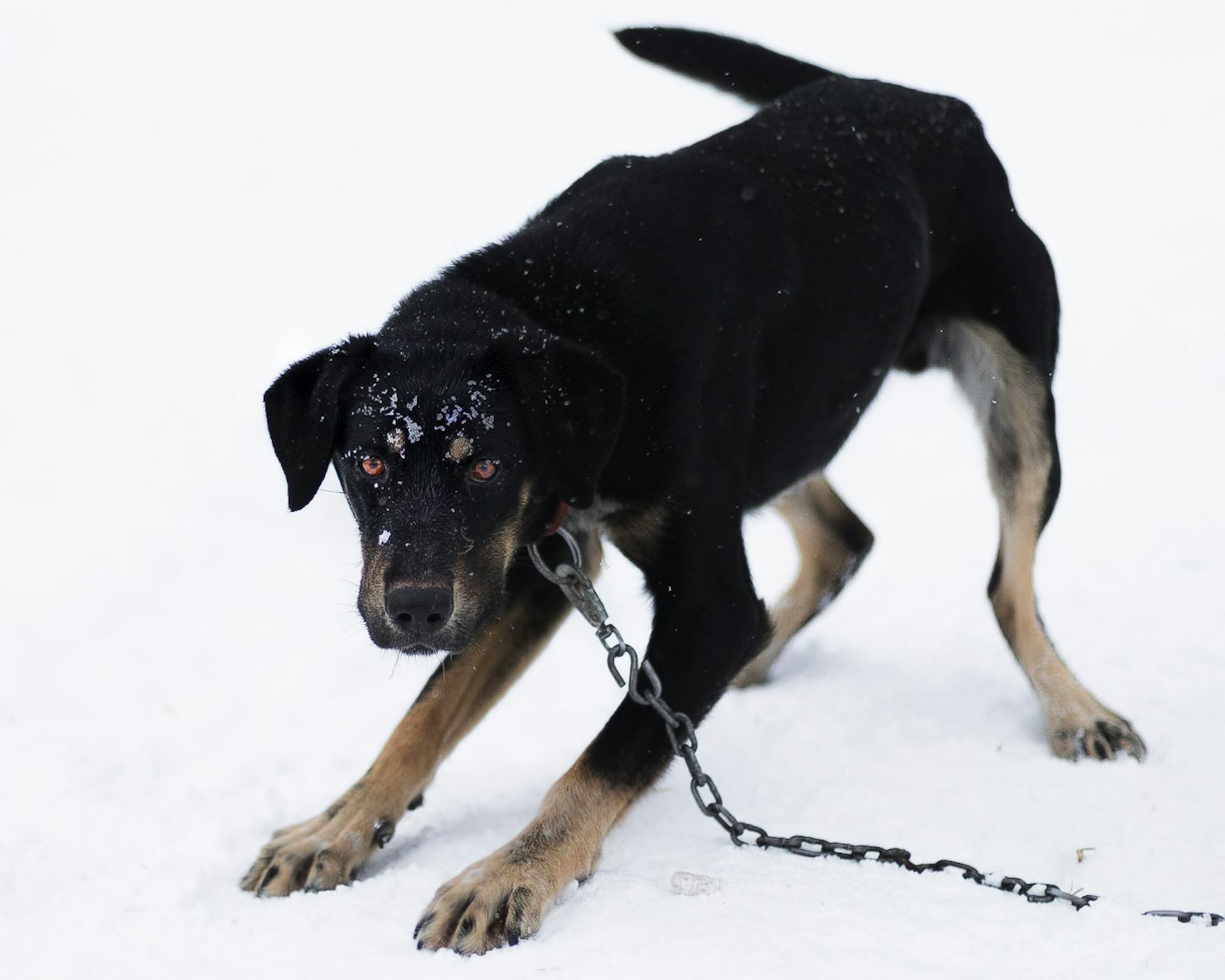
Dogs with territorial aggression will fiercely defend their perceived territory, including an area, person, or position, from perceived threats such as unfamiliar animals or people. This behavior stems from their ancestral pack instincts.
Leash aggression occurs when a normally non-aggressive dog becomes aggressive when on a leash, often directed at other dogs, especially those that are not leashed. This aggression can stem from frustration, fear, or a sense of restraint.
Dogs confined to specific areas for extended periods may develop containment aggression due to frustration, fear, or territorial instincts. This behavior can result from feeling unable to escape perceived threats.
Conflict aggression arises from dogs learning that assertive behaviors achieve desired outcomes, often escalating these behaviors over time. Dogs exhibiting conflict aggression may maintain prolonged eye contact, growl, or snarl.
Resource guarding aggression occurs when a dog perceives a threat to a valued item such as food, toys, or resting areas. This defensive behavior is a natural instinct to protect possessions or food sources.
Dogs in pain or suffering from an injury can exhibit aggression with little to no warning when touched or approached, even by familiar individuals. Consult a veterinarian to rule out pain or underlying medical conditions as the cause of sudden aggression.
Explore further: Territorial Dog Aggression
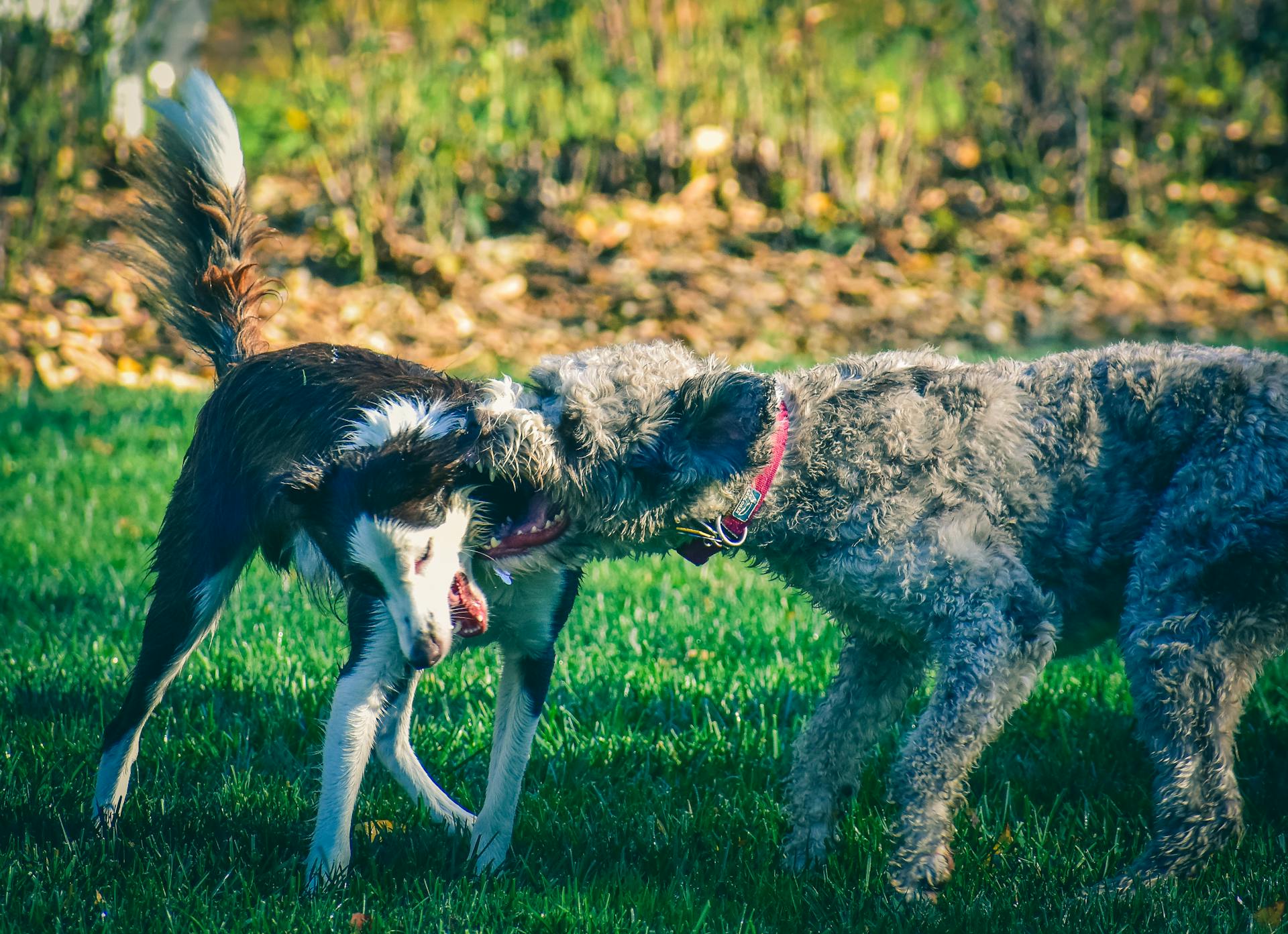
Here are some common types of dog aggression, categorized for easy reference:
- Predatory Aggression: caused by instinctual hunting behavior
- Territorial Aggression: driven by defensive instincts to protect territory
- Leash Aggression: triggered by frustration, fear, or restraint
- Containment Aggression: caused by confinement and perceived threats
- Conflict Aggression: resulting from learned assertive behaviors
- Resource Guarding Aggression: a natural instinct to protect valued items
- Fear Aggression: stemming from anxiety or fear responses
- Prey or Predatorial Aggression: an instinctual behavior to chase and attack
Problem Prevention Tips
Preventing problems with your dog requires some effort, but it's worth it for a happy and healthy relationship. Exposing your dog to well-trained dogs and various environments from a young age can help them become well-adjusted and confident.
Consistency is key when it comes to establishing clear rules and boundaries. This helps prevent confusion and reduces frustration. Consistently enforcing these rules is crucial.
Consulting professionals can also help you learn effective training, rewarding, and correcting methods. This ensures a happy, secure, and healthy relationship with your dog.
Curious to learn more? Check out: Does Cbd Help with Dog Aggression
Mat Work
Mat work is a conditioning exercise that helps your dog shift into a calmer, more relaxed state with practice and repetition.
This exercise is not about commanding your dog to stay on their mat with verbal cues, but rather about reinforcing calm behavior in a variety of situations. Reinforce your dog for calm behavior on their training mat when you walk to the door, touch the door knob, open the door, or if they appear to be acknowledging any sights, sounds, or smells from the outside.
On a similar theme: How to Calm Dog Aggression
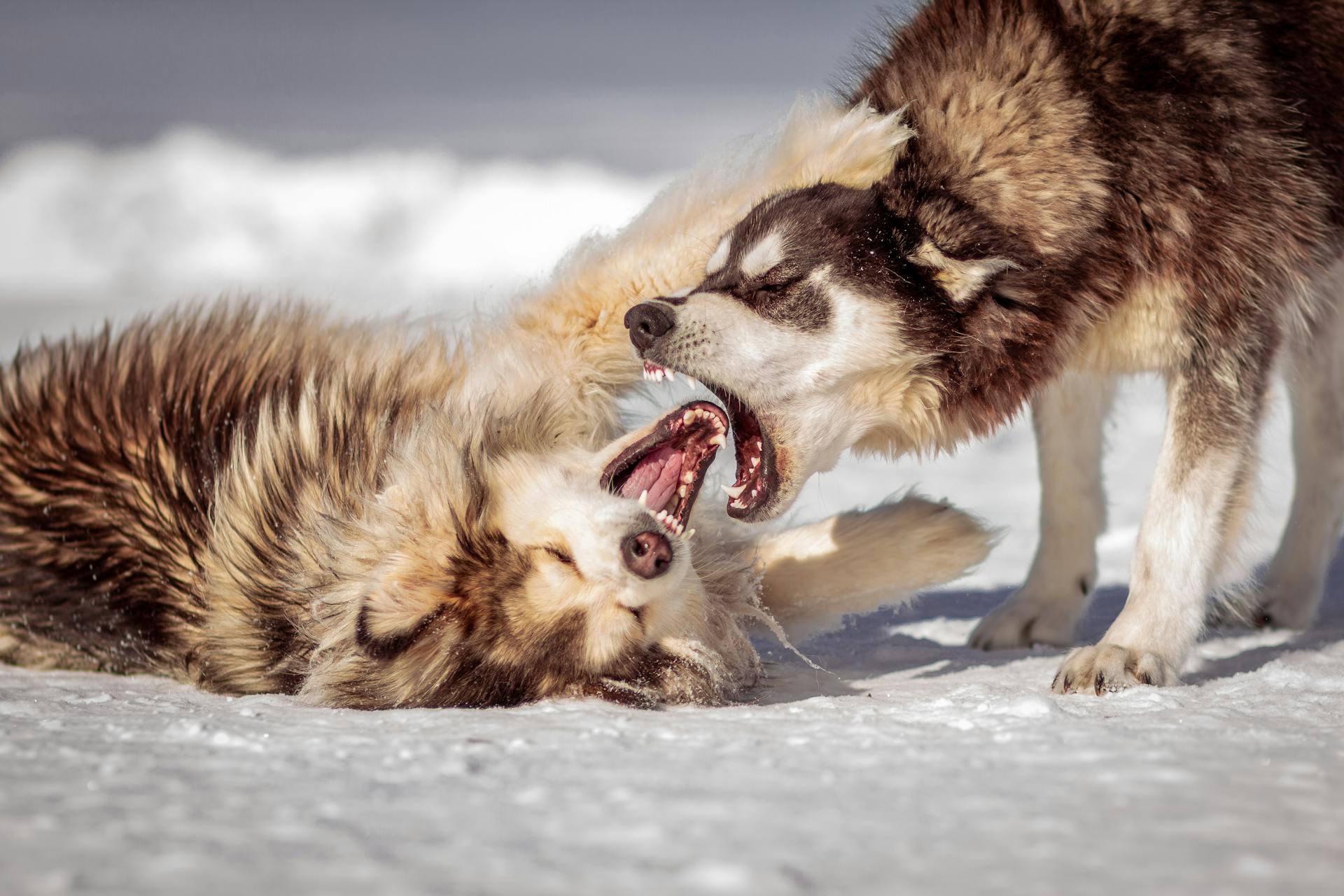
Short sessions, typically 5 minutes, are the most effective way to train this skill, and doing them once or twice a day can create a fun and rewarding experience for your dog.
By training in short sessions, you can set the stage for success in more challenging situations and make the skill sets become automatic.
Barking by the Fence
Barking by the fence is a common problem many dog owners face, especially during peak hours when neighbors are home. This type of barking is often triggered by noise from the street, such as traffic or loud conversations.
Dogs may also bark at people walking by the fence, especially if they're feeling territorial or protective of their family. In fact, research shows that dogs are more likely to bark at strangers than familiar faces.
Some dogs may bark non-stop for hours on end, which can be frustrating for owners and neighbors alike. This excessive barking can be a sign of anxiety or stress, and may require professional help to address.
To prevent barking by the fence, consider blocking your dog's view of the street with a fence or screen. This can help reduce their stress levels and prevent unwanted barking.
Discover more: Dog Fence Aggression
Dominant
Dominant aggression is a type of dog behavior where a dog displays aggression to assert its dominance over others, including people and other animals.
Dominant aggression can manifest in various ways, such as growling, snapping, or even biting when a dog feels its status is being challenged.
In some cases, dominant aggression can be a learned behavior, often as a result of a dog's environment and socialization.
For example, if a dog is not properly socialized or is not given clear boundaries, it may develop dominant aggression as a way to assert its dominance over others.
Here are some common signs of dominant aggression in dogs:
- Growling or snapping when approached or touched
- Standing over others or blocking their path
- Refusing to back down or yielding to others
- Showing aggression towards other dogs or animals
It's essential to address dominant aggression early on to prevent it from escalating into more severe behavior.
Territorial-Based
Territorial-Based Aggression is a type of aggression that stems from a dog's ancestral pack instincts, where maintaining a defined territory was crucial for survival and protecting resources. This behavior is a defensive response to perceived threats, including unfamiliar animals or people.
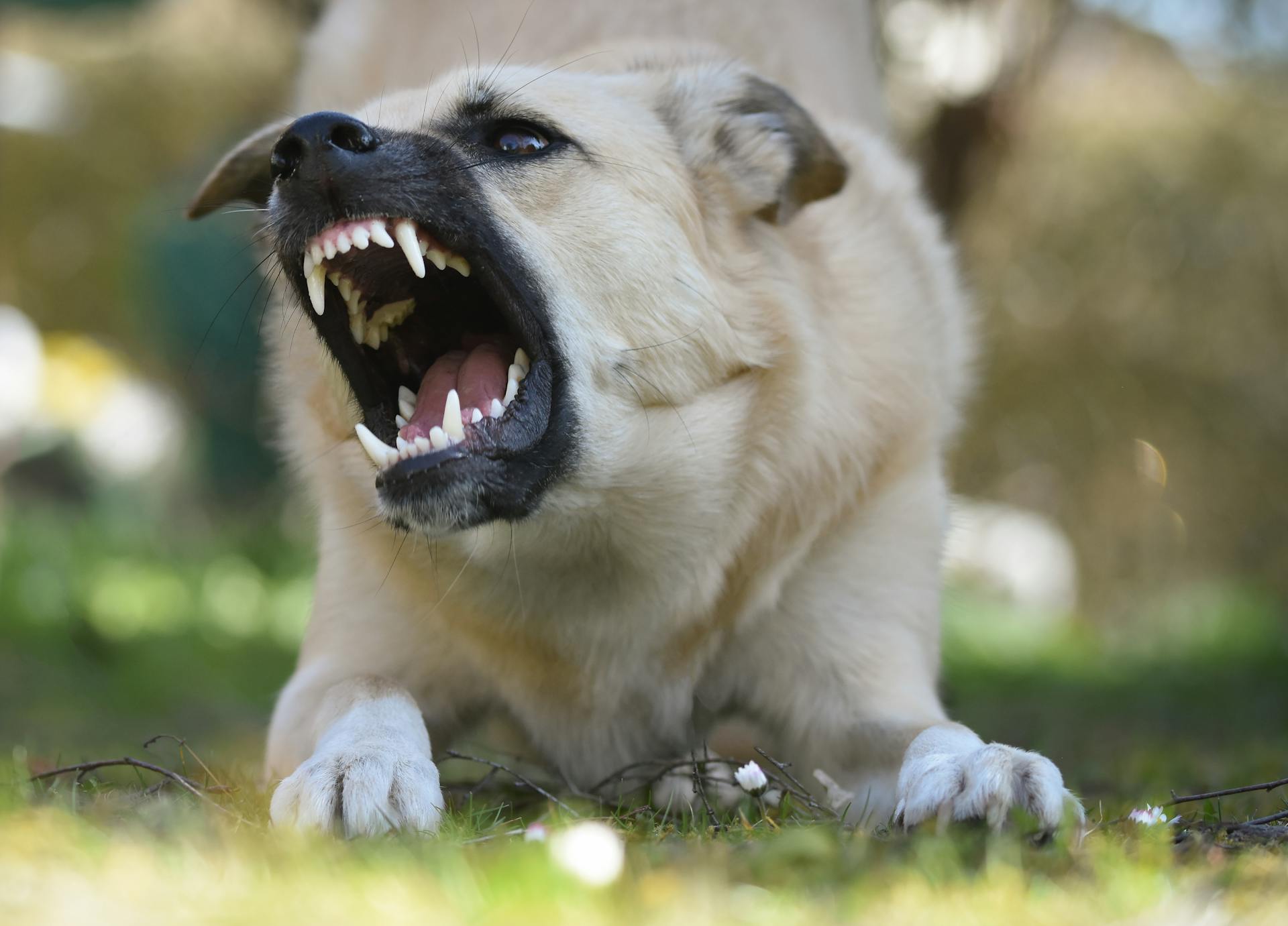
Dogs with territorial aggression often protect an area, person, or position they consider their own. This can lead to aggressive behavior towards anyone who approaches or enters their perceived territory.
Leash aggression can also be a form of territorial aggression, as dogs may feel a sense of restraint or protectiveness when on a leash, leading to aggression towards other dogs or people.
Here are some common signs of territorial aggression:
- Growling or snarling when approached or entered by others
- Barking or lunging at perceived threats
- Stiffening or raising hackles when others approach their territory
To prevent territorial aggression, it's essential to establish clear boundaries and rules for your dog's territory. This can include designating specific areas as off-limits and providing a safe and comfortable space for your dog to retreat to when feeling overwhelmed.
Treating and Managing
Consult a veterinarian to rule out any medical issues contributing to your dog's aggression. This will help you identify the root cause of the problem.
Seek guidance from a certified dog trainer or behaviorist who can assess your dog's behavior and develop a tailored treatment plan. They will help you understand what triggers your dog's aggressive behavior.
Discover more: Will Neutering Stop Dog Aggression
Identify the triggers that provoke aggressive behavior in your dog, such as strangers, noises, or movements, by keeping a journal to track situations or stimuli that elicit aggressive responses.
Modify your dog's environment to reduce opportunities for aggression and minimize exposure to triggers, using tools such as baby gates or crates to block access to the door.
To manage your dog's aggression at the door, consider the following tips:
- Use positive reinforcement to encourage calm behavior around the door.
- Gradually increase exposure to triggers, starting from a safe distance.
- Practice consistency and patience, as treating aggression requires time and effort.
Stay calm and persistent in your efforts to help your dog overcome aggression, and celebrate progress along the way.
Emotional and Social Aspects
Your dog's emotional response to visitors at the door is a key factor in understanding dog aggression. Nearly all reactivity is rooted in fear.
Punishing your dog for reactive behavior can actually make things worse. If you yank on your dog or yell at him to stop, he'll think people make bad things happen, which can escalate the situation.
Your dog is actually trying to tell you something by growling or showing aggression at the door. He's saying he feels too close to what's making him anxious, and that's a clear warning sign that he needs space.
Your Emotional Response
Your emotional response can actually be a major obstacle in addressing your dog's reactivity. Nearly all reactivity is rooted in fear.
Punishing your dog for reactive behavior can make things worse, not better. If you yank on your dog or yell at him to stop, you're reinforcing the idea that people make bad things happen.
Your dog is trying to communicate with you, and his behavior is a warning sign that he's feeling anxious. He's telling you that he's too close to what's making him anxious.
By understanding your dog's emotional response, you can learn to recognize the warning signs of anxiety and take steps to prevent reactivity.
A unique perspective: Why Does My Dog's Red Rocket Come Out When Pooping?
Household Members
Living with household members can be a challenge for dogs, especially if they're not socialized to new people. It can be very disappointing to bring home a new dog and find that the dog doesn’t like your spouse, housemate, or other person living in your home.
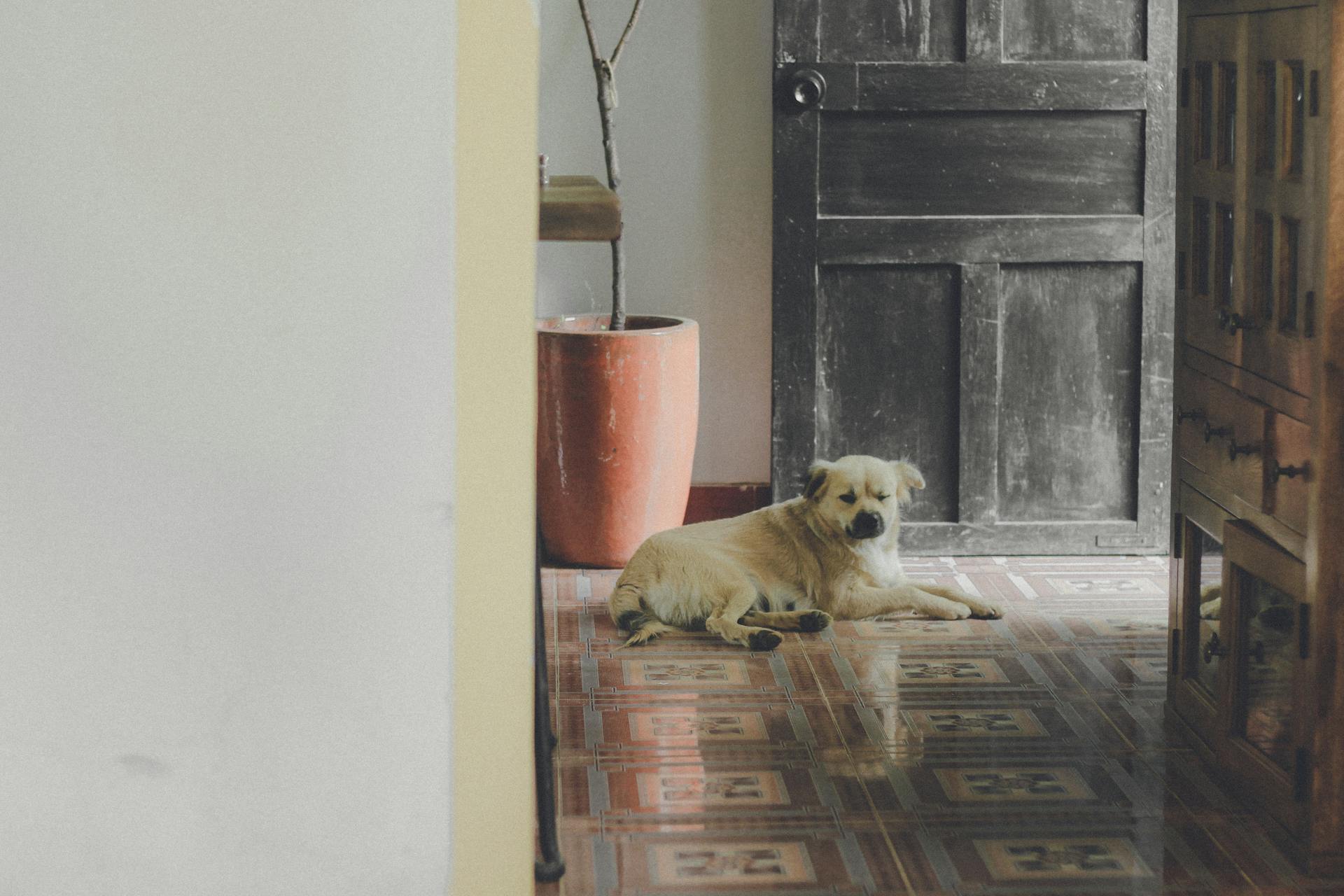
Moving to a new environment is always stressful, but for some dogs, it’s traumatic. Each person is a new and frightening experience for a dog that has not learned to trust. People can’t force a dog to trust them, but they CAN show the dog gradually over time that they are safe.
If your dog doesn’t like your child, that’s a more serious issue. If he is reacting to something your child does, like picking up or falling on your dog, that’s one thing. If your child is too young to understand or if your dog just doesn’t like children, this is the wrong home for your dog.
Related reading: Dog Food Aggression towards Child
Specific Situations
When someone comes to the door, your dog may feel scared or anxious. This is normal, but it's essential to teach your dog to be comfortable around people.
Start by working with your dog far enough from strangers that your dog doesn't react. If your dog does react, you are too close and need to move back. Stay stationary, so you can maintain a comfortable distance throughout the training.
These sessions should be short, but repeated often, moving closer as your dog's comfort level increases. You want to change your dog's emotional response from "people are scary" to "people make good things happen".
Give your dog tiny treats, one after another, when they see a person. Save the yummiest food for this exercise, so your dog learns "scary person = steak" (or string cheese or turkey hotdogs or whatever else your dog loves).
Understanding Aggression
Aggression is not limited to large and loud dogs; even small and timid dogs can exhibit aggressive behaviors.
Understanding and identifying the specific types of aggression your dog displays is crucial for addressing the behavior.
Aggression is a complex and serious behavior problem in dogs, making it a leading cause for dogs being surrendered to animal shelters or euthanized each year.
Unchecked aggression can lead to severe consequences such as bites, destructive behavior, or territorial aggression.
As experts in dog aggression, we know that understanding the complexities of canine aggression is essential for responsible pet ownership and ensuring the safety and well-being of both dogs and the people around them.
Understanding the specific types of aggression your dog displays is a crucial first step in addressing the behavior, and this knowledge is essential for responsible pet ownership.
Frequently Asked Questions
How to stop dog door aggression?
To prevent dog door aggression, use a dog leash, crate, or secure outdoor area to manage your dog's behavior when visitors arrive. By establishing a safe and controlled environment, you can reduce the risk of aggression and create a more welcoming atmosphere.
Featured Images: pexels.com


